Corporate Hedging and Currency Risk Management
VerifiedAdded on 2021/04/17
|12
|2552
|30
AI Summary
This assignment provides an in-depth analysis of corporate hedging practices, including currency risk management policies and procedures used by companies listed on the Nairobi Security Exchange. It also examines the impact of hedging on companies' financial performance and explores the determinants of hedging practices. The assignment draws on research from various sources, including academic journals and industry reports, to provide a comprehensive understanding of corporate hedging practices.
Contribute Materials
Your contribution can guide someone’s learning journey. Share your
documents today.
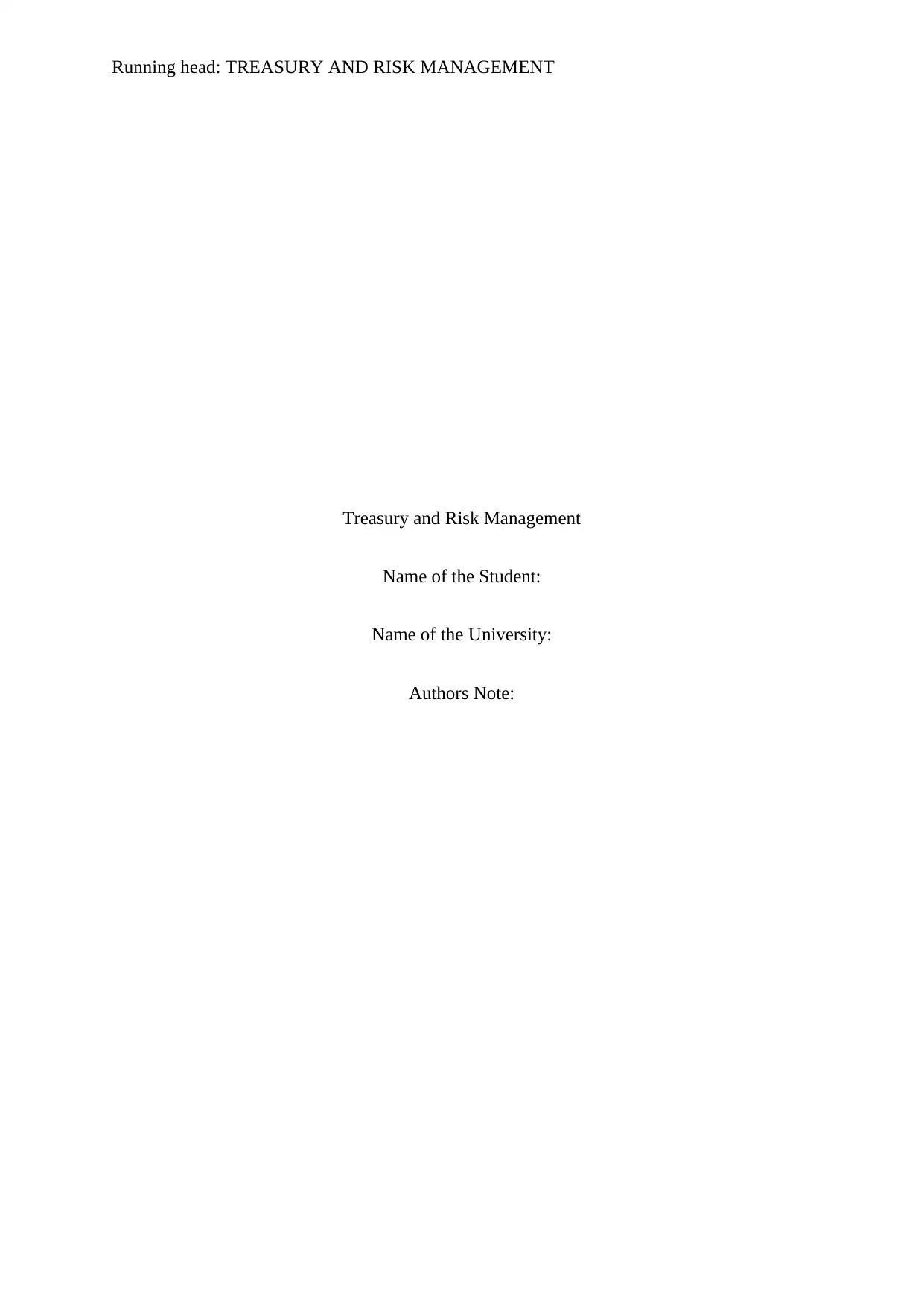
Running head: TREASURY AND RISK MANAGEMENT
Treasury and Risk Management
Name of the Student:
Name of the University:
Authors Note:
Treasury and Risk Management
Name of the Student:
Name of the University:
Authors Note:
Secure Best Marks with AI Grader
Need help grading? Try our AI Grader for instant feedback on your assignments.
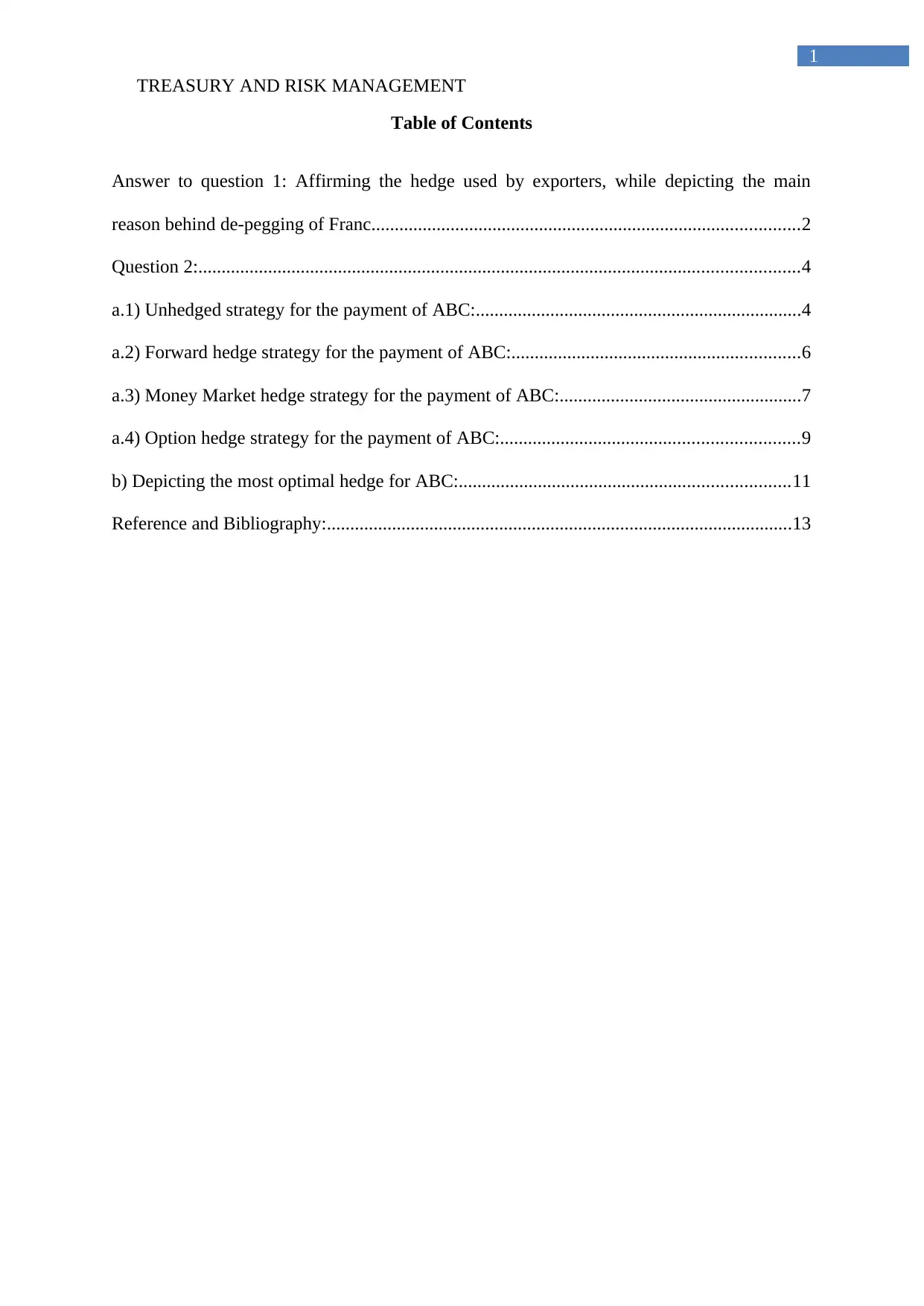
TREASURY AND RISK MANAGEMENT
1
Table of Contents
Answer to question 1: Affirming the hedge used by exporters, while depicting the main
reason behind de-pegging of Franc............................................................................................2
Question 2:.................................................................................................................................4
a.1) Unhedged strategy for the payment of ABC:......................................................................4
a.2) Forward hedge strategy for the payment of ABC:..............................................................6
a.3) Money Market hedge strategy for the payment of ABC:....................................................7
a.4) Option hedge strategy for the payment of ABC:................................................................9
b) Depicting the most optimal hedge for ABC:.......................................................................11
Reference and Bibliography:....................................................................................................13
1
Table of Contents
Answer to question 1: Affirming the hedge used by exporters, while depicting the main
reason behind de-pegging of Franc............................................................................................2
Question 2:.................................................................................................................................4
a.1) Unhedged strategy for the payment of ABC:......................................................................4
a.2) Forward hedge strategy for the payment of ABC:..............................................................6
a.3) Money Market hedge strategy for the payment of ABC:....................................................7
a.4) Option hedge strategy for the payment of ABC:................................................................9
b) Depicting the most optimal hedge for ABC:.......................................................................11
Reference and Bibliography:....................................................................................................13
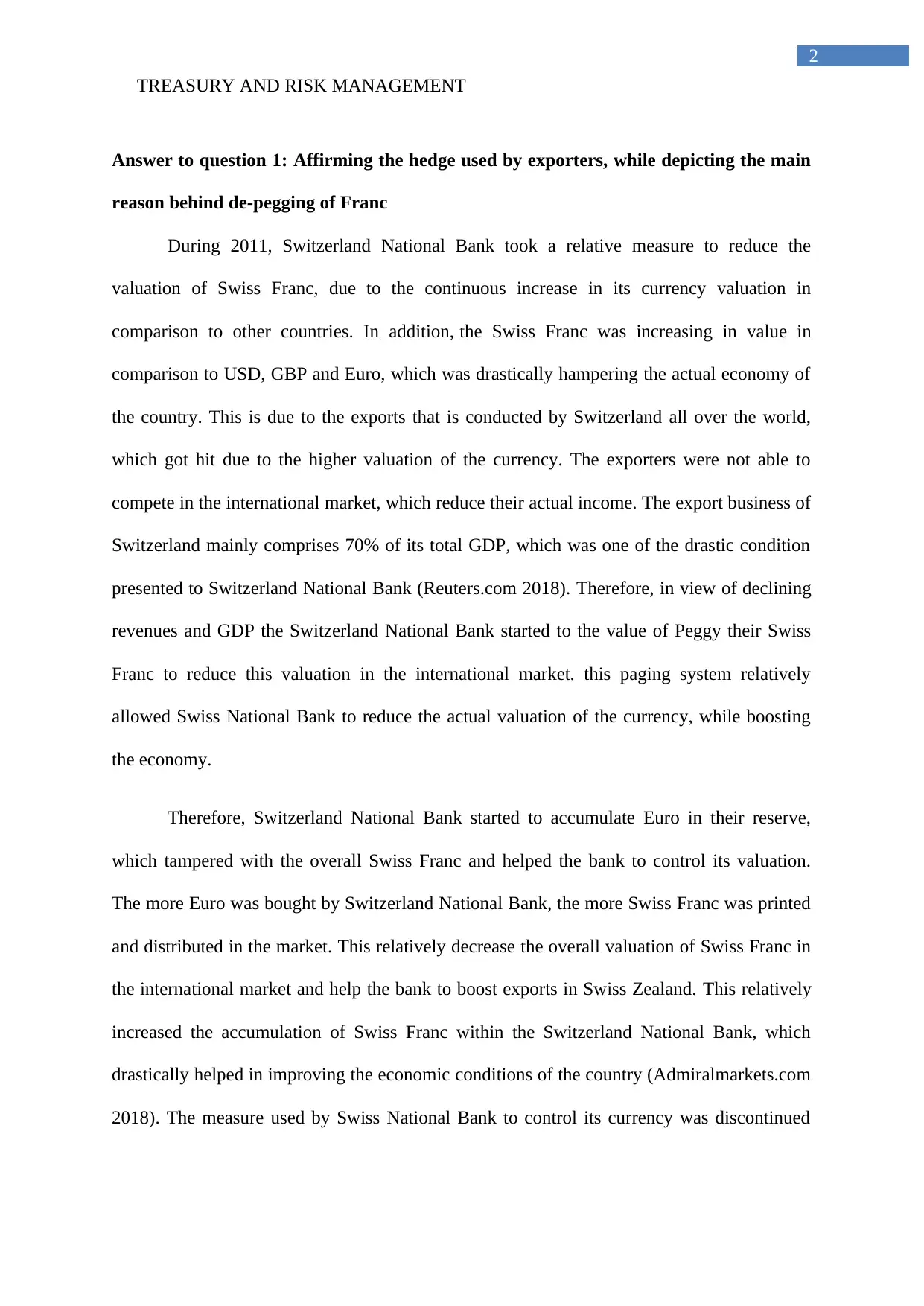
TREASURY AND RISK MANAGEMENT
2
Answer to question 1: Affirming the hedge used by exporters, while depicting the main
reason behind de-pegging of Franc
During 2011, Switzerland National Bank took a relative measure to reduce the
valuation of Swiss Franc, due to the continuous increase in its currency valuation in
comparison to other countries. In addition, the Swiss Franc was increasing in value in
comparison to USD, GBP and Euro, which was drastically hampering the actual economy of
the country. This is due to the exports that is conducted by Switzerland all over the world,
which got hit due to the higher valuation of the currency. The exporters were not able to
compete in the international market, which reduce their actual income. The export business of
Switzerland mainly comprises 70% of its total GDP, which was one of the drastic condition
presented to Switzerland National Bank (Reuters.com 2018). Therefore, in view of declining
revenues and GDP the Switzerland National Bank started to the value of Peggy their Swiss
Franc to reduce this valuation in the international market. this paging system relatively
allowed Swiss National Bank to reduce the actual valuation of the currency, while boosting
the economy.
Therefore, Switzerland National Bank started to accumulate Euro in their reserve,
which tampered with the overall Swiss Franc and helped the bank to control its valuation.
The more Euro was bought by Switzerland National Bank, the more Swiss Franc was printed
and distributed in the market. This relatively decrease the overall valuation of Swiss Franc in
the international market and help the bank to boost exports in Swiss Zealand. This relatively
increased the accumulation of Swiss Franc within the Switzerland National Bank, which
drastically helped in improving the economic conditions of the country (Admiralmarkets.com
2018). The measure used by Swiss National Bank to control its currency was discontinued
2
Answer to question 1: Affirming the hedge used by exporters, while depicting the main
reason behind de-pegging of Franc
During 2011, Switzerland National Bank took a relative measure to reduce the
valuation of Swiss Franc, due to the continuous increase in its currency valuation in
comparison to other countries. In addition, the Swiss Franc was increasing in value in
comparison to USD, GBP and Euro, which was drastically hampering the actual economy of
the country. This is due to the exports that is conducted by Switzerland all over the world,
which got hit due to the higher valuation of the currency. The exporters were not able to
compete in the international market, which reduce their actual income. The export business of
Switzerland mainly comprises 70% of its total GDP, which was one of the drastic condition
presented to Switzerland National Bank (Reuters.com 2018). Therefore, in view of declining
revenues and GDP the Switzerland National Bank started to the value of Peggy their Swiss
Franc to reduce this valuation in the international market. this paging system relatively
allowed Swiss National Bank to reduce the actual valuation of the currency, while boosting
the economy.
Therefore, Switzerland National Bank started to accumulate Euro in their reserve,
which tampered with the overall Swiss Franc and helped the bank to control its valuation.
The more Euro was bought by Switzerland National Bank, the more Swiss Franc was printed
and distributed in the market. This relatively decrease the overall valuation of Swiss Franc in
the international market and help the bank to boost exports in Swiss Zealand. This relatively
increased the accumulation of Swiss Franc within the Switzerland National Bank, which
drastically helped in improving the economic conditions of the country (Admiralmarkets.com
2018). The measure used by Swiss National Bank to control its currency was discontinued
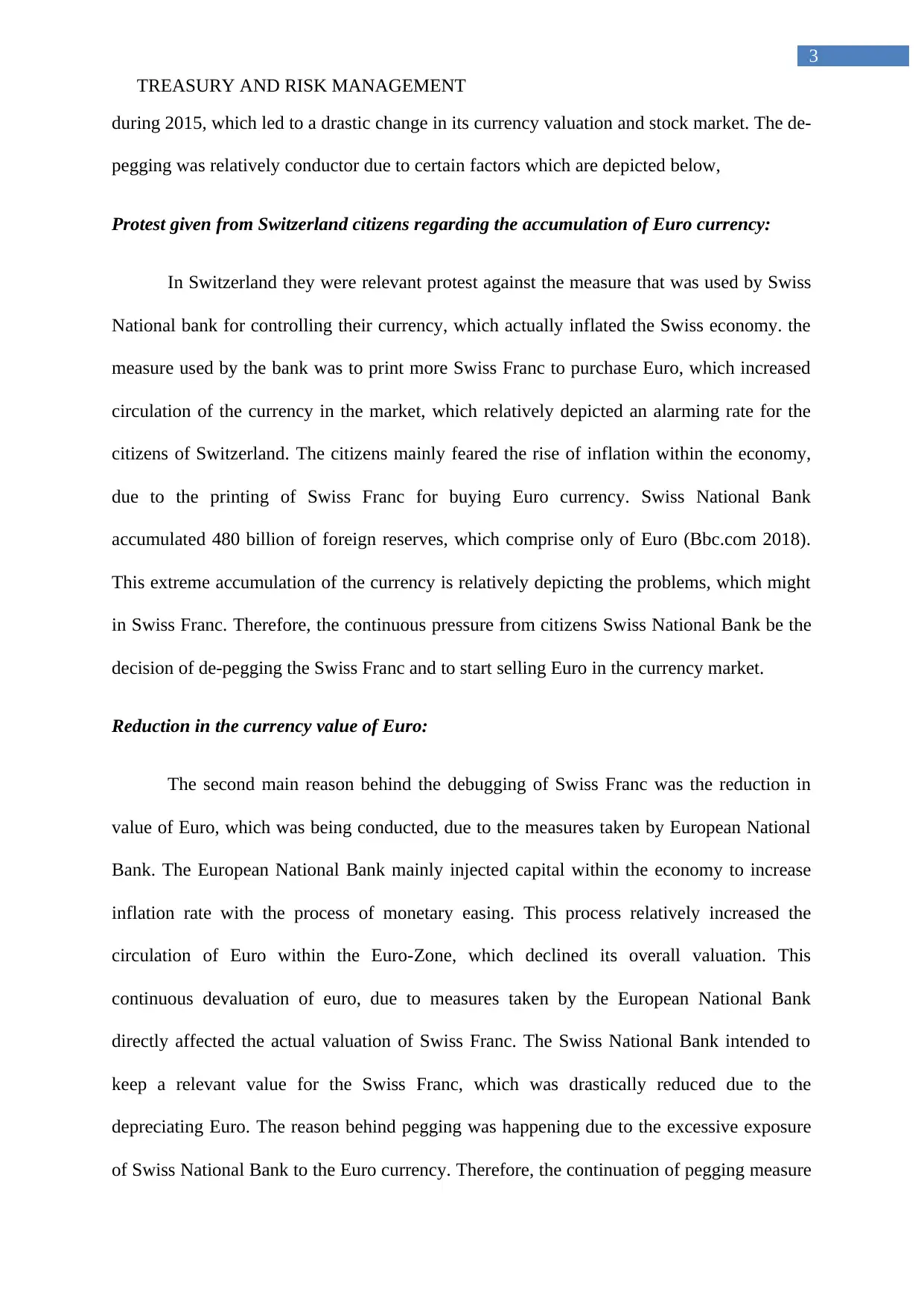
TREASURY AND RISK MANAGEMENT
3
during 2015, which led to a drastic change in its currency valuation and stock market. The de-
pegging was relatively conductor due to certain factors which are depicted below,
Protest given from Switzerland citizens regarding the accumulation of Euro currency:
In Switzerland they were relevant protest against the measure that was used by Swiss
National bank for controlling their currency, which actually inflated the Swiss economy. the
measure used by the bank was to print more Swiss Franc to purchase Euro, which increased
circulation of the currency in the market, which relatively depicted an alarming rate for the
citizens of Switzerland. The citizens mainly feared the rise of inflation within the economy,
due to the printing of Swiss Franc for buying Euro currency. Swiss National Bank
accumulated 480 billion of foreign reserves, which comprise only of Euro (Bbc.com 2018).
This extreme accumulation of the currency is relatively depicting the problems, which might
in Swiss Franc. Therefore, the continuous pressure from citizens Swiss National Bank be the
decision of de-pegging the Swiss Franc and to start selling Euro in the currency market.
Reduction in the currency value of Euro:
The second main reason behind the debugging of Swiss Franc was the reduction in
value of Euro, which was being conducted, due to the measures taken by European National
Bank. The European National Bank mainly injected capital within the economy to increase
inflation rate with the process of monetary easing. This process relatively increased the
circulation of Euro within the Euro-Zone, which declined its overall valuation. This
continuous devaluation of euro, due to measures taken by the European National Bank
directly affected the actual valuation of Swiss Franc. The Swiss National Bank intended to
keep a relevant value for the Swiss Franc, which was drastically reduced due to the
depreciating Euro. The reason behind pegging was happening due to the excessive exposure
of Swiss National Bank to the Euro currency. Therefore, the continuation of pegging measure
3
during 2015, which led to a drastic change in its currency valuation and stock market. The de-
pegging was relatively conductor due to certain factors which are depicted below,
Protest given from Switzerland citizens regarding the accumulation of Euro currency:
In Switzerland they were relevant protest against the measure that was used by Swiss
National bank for controlling their currency, which actually inflated the Swiss economy. the
measure used by the bank was to print more Swiss Franc to purchase Euro, which increased
circulation of the currency in the market, which relatively depicted an alarming rate for the
citizens of Switzerland. The citizens mainly feared the rise of inflation within the economy,
due to the printing of Swiss Franc for buying Euro currency. Swiss National Bank
accumulated 480 billion of foreign reserves, which comprise only of Euro (Bbc.com 2018).
This extreme accumulation of the currency is relatively depicting the problems, which might
in Swiss Franc. Therefore, the continuous pressure from citizens Swiss National Bank be the
decision of de-pegging the Swiss Franc and to start selling Euro in the currency market.
Reduction in the currency value of Euro:
The second main reason behind the debugging of Swiss Franc was the reduction in
value of Euro, which was being conducted, due to the measures taken by European National
Bank. The European National Bank mainly injected capital within the economy to increase
inflation rate with the process of monetary easing. This process relatively increased the
circulation of Euro within the Euro-Zone, which declined its overall valuation. This
continuous devaluation of euro, due to measures taken by the European National Bank
directly affected the actual valuation of Swiss Franc. The Swiss National Bank intended to
keep a relevant value for the Swiss Franc, which was drastically reduced due to the
depreciating Euro. The reason behind pegging was happening due to the excessive exposure
of Swiss National Bank to the Euro currency. Therefore, the continuation of pegging measure
Secure Best Marks with AI Grader
Need help grading? Try our AI Grader for instant feedback on your assignments.
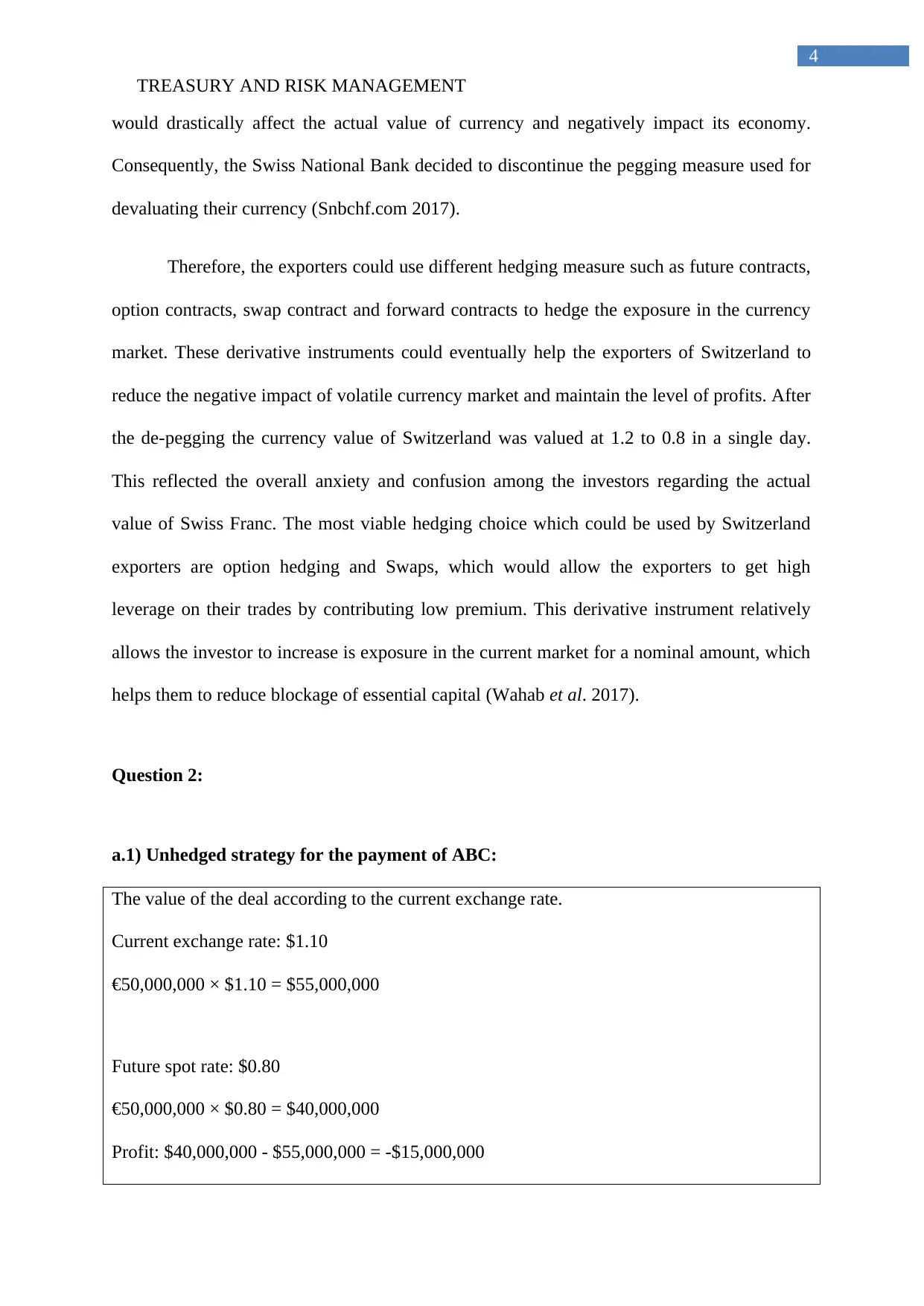
TREASURY AND RISK MANAGEMENT
4
would drastically affect the actual value of currency and negatively impact its economy.
Consequently, the Swiss National Bank decided to discontinue the pegging measure used for
devaluating their currency (Snbchf.com 2017).
Therefore, the exporters could use different hedging measure such as future contracts,
option contracts, swap contract and forward contracts to hedge the exposure in the currency
market. These derivative instruments could eventually help the exporters of Switzerland to
reduce the negative impact of volatile currency market and maintain the level of profits. After
the de-pegging the currency value of Switzerland was valued at 1.2 to 0.8 in a single day.
This reflected the overall anxiety and confusion among the investors regarding the actual
value of Swiss Franc. The most viable hedging choice which could be used by Switzerland
exporters are option hedging and Swaps, which would allow the exporters to get high
leverage on their trades by contributing low premium. This derivative instrument relatively
allows the investor to increase is exposure in the current market for a nominal amount, which
helps them to reduce blockage of essential capital (Wahab et al. 2017).
Question 2:
a.1) Unhedged strategy for the payment of ABC:
The value of the deal according to the current exchange rate.
Current exchange rate: $1.10
€50,000,000 × $1.10 = $55,000,000
Future spot rate: $0.80
€50,000,000 × $0.80 = $40,000,000
Profit: $40,000,000 - $55,000,000 = -$15,000,000
4
would drastically affect the actual value of currency and negatively impact its economy.
Consequently, the Swiss National Bank decided to discontinue the pegging measure used for
devaluating their currency (Snbchf.com 2017).
Therefore, the exporters could use different hedging measure such as future contracts,
option contracts, swap contract and forward contracts to hedge the exposure in the currency
market. These derivative instruments could eventually help the exporters of Switzerland to
reduce the negative impact of volatile currency market and maintain the level of profits. After
the de-pegging the currency value of Switzerland was valued at 1.2 to 0.8 in a single day.
This reflected the overall anxiety and confusion among the investors regarding the actual
value of Swiss Franc. The most viable hedging choice which could be used by Switzerland
exporters are option hedging and Swaps, which would allow the exporters to get high
leverage on their trades by contributing low premium. This derivative instrument relatively
allows the investor to increase is exposure in the current market for a nominal amount, which
helps them to reduce blockage of essential capital (Wahab et al. 2017).
Question 2:
a.1) Unhedged strategy for the payment of ABC:
The value of the deal according to the current exchange rate.
Current exchange rate: $1.10
€50,000,000 × $1.10 = $55,000,000
Future spot rate: $0.80
€50,000,000 × $0.80 = $40,000,000
Profit: $40,000,000 - $55,000,000 = -$15,000,000
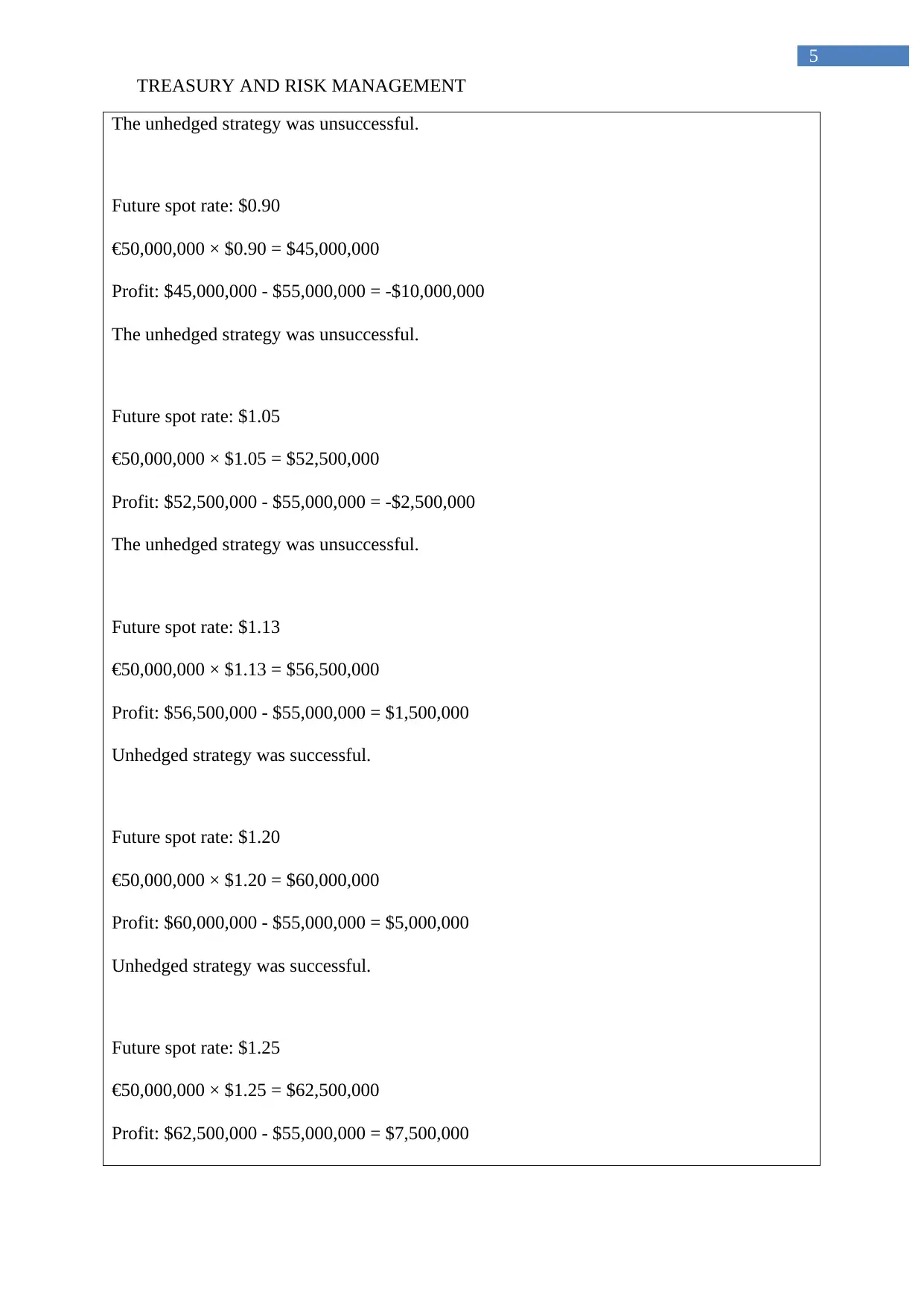
TREASURY AND RISK MANAGEMENT
5
The unhedged strategy was unsuccessful.
Future spot rate: $0.90
€50,000,000 × $0.90 = $45,000,000
Profit: $45,000,000 - $55,000,000 = -$10,000,000
The unhedged strategy was unsuccessful.
Future spot rate: $1.05
€50,000,000 × $1.05 = $52,500,000
Profit: $52,500,000 - $55,000,000 = -$2,500,000
The unhedged strategy was unsuccessful.
Future spot rate: $1.13
€50,000,000 × $1.13 = $56,500,000
Profit: $56,500,000 - $55,000,000 = $1,500,000
Unhedged strategy was successful.
Future spot rate: $1.20
€50,000,000 × $1.20 = $60,000,000
Profit: $60,000,000 - $55,000,000 = $5,000,000
Unhedged strategy was successful.
Future spot rate: $1.25
€50,000,000 × $1.25 = $62,500,000
Profit: $62,500,000 - $55,000,000 = $7,500,000
5
The unhedged strategy was unsuccessful.
Future spot rate: $0.90
€50,000,000 × $0.90 = $45,000,000
Profit: $45,000,000 - $55,000,000 = -$10,000,000
The unhedged strategy was unsuccessful.
Future spot rate: $1.05
€50,000,000 × $1.05 = $52,500,000
Profit: $52,500,000 - $55,000,000 = -$2,500,000
The unhedged strategy was unsuccessful.
Future spot rate: $1.13
€50,000,000 × $1.13 = $56,500,000
Profit: $56,500,000 - $55,000,000 = $1,500,000
Unhedged strategy was successful.
Future spot rate: $1.20
€50,000,000 × $1.20 = $60,000,000
Profit: $60,000,000 - $55,000,000 = $5,000,000
Unhedged strategy was successful.
Future spot rate: $1.25
€50,000,000 × $1.25 = $62,500,000
Profit: $62,500,000 - $55,000,000 = $7,500,000
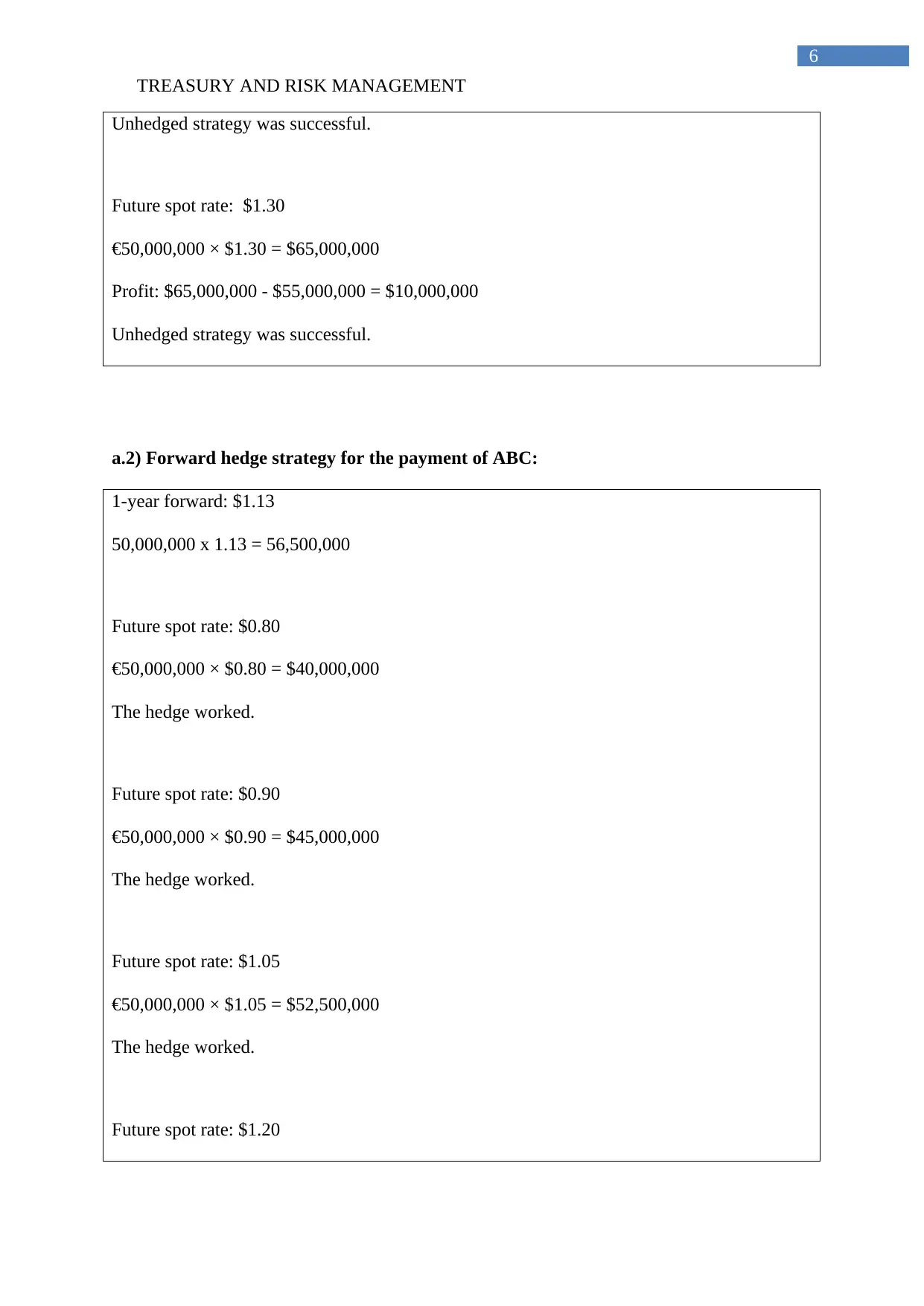
TREASURY AND RISK MANAGEMENT
6
Unhedged strategy was successful.
Future spot rate: $1.30
€50,000,000 × $1.30 = $65,000,000
Profit: $65,000,000 - $55,000,000 = $10,000,000
Unhedged strategy was successful.
a.2) Forward hedge strategy for the payment of ABC:
1-year forward: $1.13
50,000,000 x 1.13 = 56,500,000
Future spot rate: $0.80
€50,000,000 × $0.80 = $40,000,000
The hedge worked.
Future spot rate: $0.90
€50,000,000 × $0.90 = $45,000,000
The hedge worked.
Future spot rate: $1.05
€50,000,000 × $1.05 = $52,500,000
The hedge worked.
Future spot rate: $1.20
6
Unhedged strategy was successful.
Future spot rate: $1.30
€50,000,000 × $1.30 = $65,000,000
Profit: $65,000,000 - $55,000,000 = $10,000,000
Unhedged strategy was successful.
a.2) Forward hedge strategy for the payment of ABC:
1-year forward: $1.13
50,000,000 x 1.13 = 56,500,000
Future spot rate: $0.80
€50,000,000 × $0.80 = $40,000,000
The hedge worked.
Future spot rate: $0.90
€50,000,000 × $0.90 = $45,000,000
The hedge worked.
Future spot rate: $1.05
€50,000,000 × $1.05 = $52,500,000
The hedge worked.
Future spot rate: $1.20
Paraphrase This Document
Need a fresh take? Get an instant paraphrase of this document with our AI Paraphraser
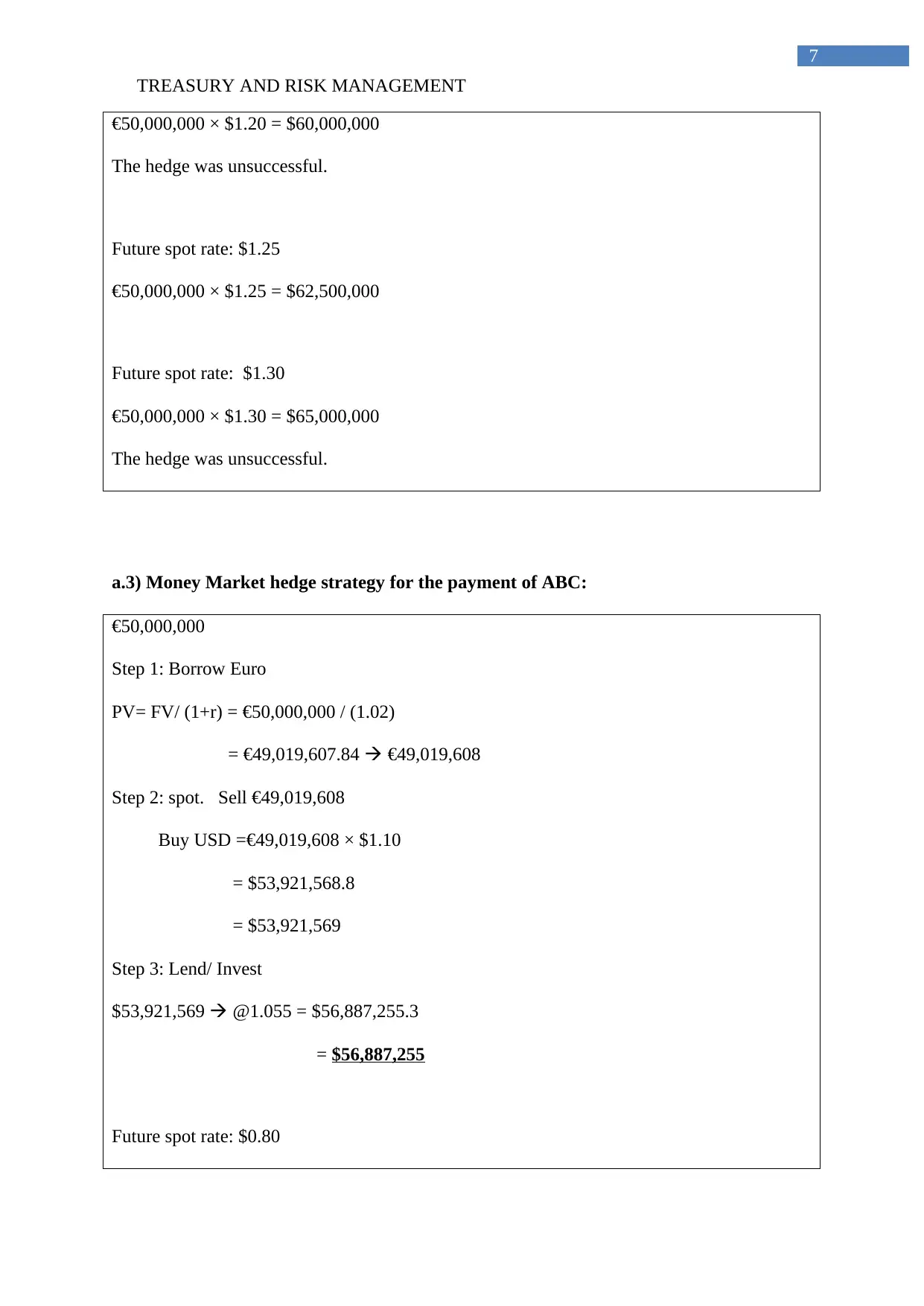
TREASURY AND RISK MANAGEMENT
7
€50,000,000 × $1.20 = $60,000,000
The hedge was unsuccessful.
Future spot rate: $1.25
€50,000,000 × $1.25 = $62,500,000
Future spot rate: $1.30
€50,000,000 × $1.30 = $65,000,000
The hedge was unsuccessful.
a.3) Money Market hedge strategy for the payment of ABC:
€50,000,000
Step 1: Borrow Euro
PV= FV/ (1+r) = €50,000,000 / (1.02)
= €49,019,607.84 €49,019,608
Step 2: spot. Sell €49,019,608
Buy USD =€49,019,608 × $1.10
= $53,921,568.8
= $53,921,569
Step 3: Lend/ Invest
$53,921,569 @1.055 = $56,887,255.3
= $56,887,255
Future spot rate: $0.80
7
€50,000,000 × $1.20 = $60,000,000
The hedge was unsuccessful.
Future spot rate: $1.25
€50,000,000 × $1.25 = $62,500,000
Future spot rate: $1.30
€50,000,000 × $1.30 = $65,000,000
The hedge was unsuccessful.
a.3) Money Market hedge strategy for the payment of ABC:
€50,000,000
Step 1: Borrow Euro
PV= FV/ (1+r) = €50,000,000 / (1.02)
= €49,019,607.84 €49,019,608
Step 2: spot. Sell €49,019,608
Buy USD =€49,019,608 × $1.10
= $53,921,568.8
= $53,921,569
Step 3: Lend/ Invest
$53,921,569 @1.055 = $56,887,255.3
= $56,887,255
Future spot rate: $0.80
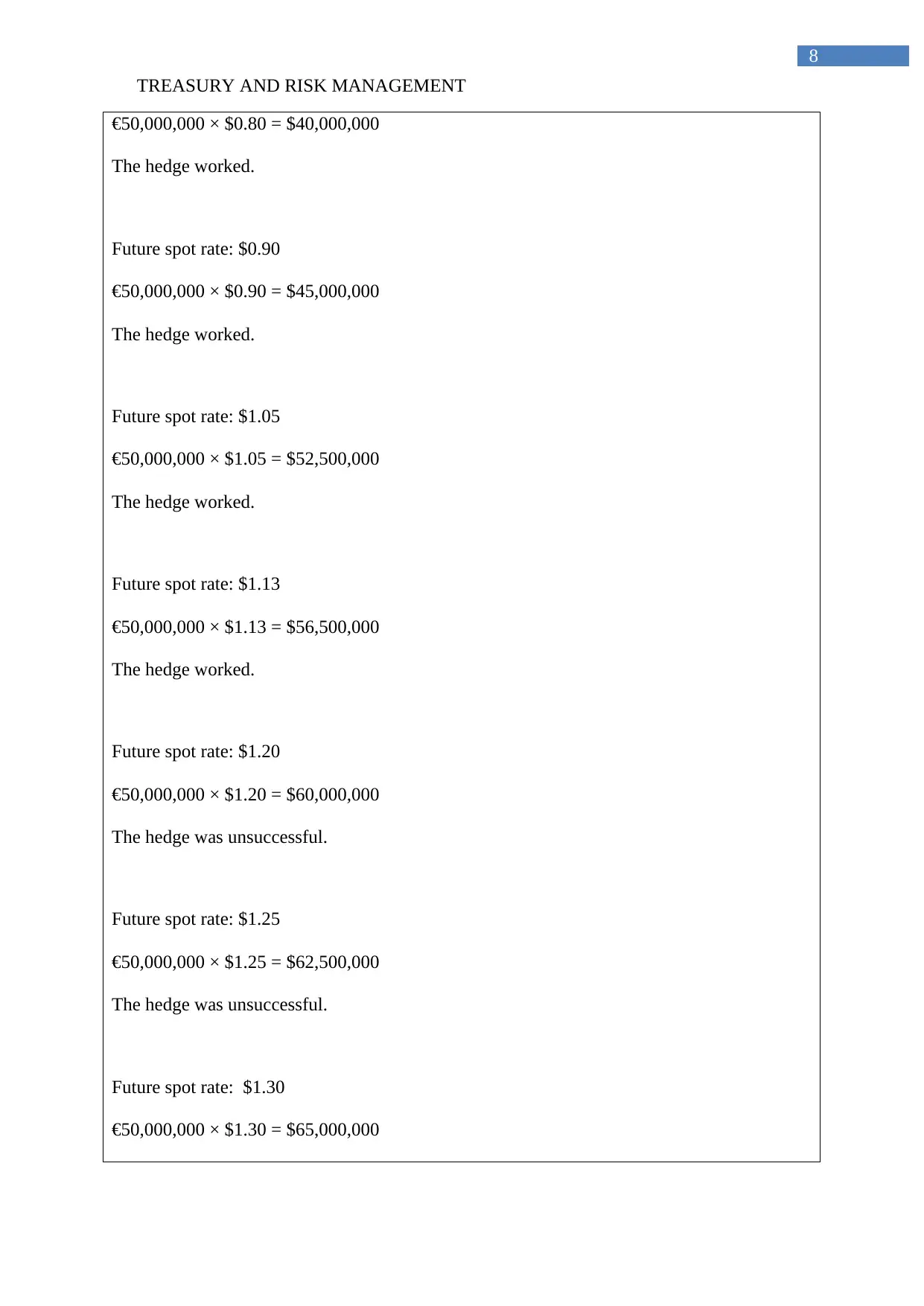
TREASURY AND RISK MANAGEMENT
8
€50,000,000 × $0.80 = $40,000,000
The hedge worked.
Future spot rate: $0.90
€50,000,000 × $0.90 = $45,000,000
The hedge worked.
Future spot rate: $1.05
€50,000,000 × $1.05 = $52,500,000
The hedge worked.
Future spot rate: $1.13
€50,000,000 × $1.13 = $56,500,000
The hedge worked.
Future spot rate: $1.20
€50,000,000 × $1.20 = $60,000,000
The hedge was unsuccessful.
Future spot rate: $1.25
€50,000,000 × $1.25 = $62,500,000
The hedge was unsuccessful.
Future spot rate: $1.30
€50,000,000 × $1.30 = $65,000,000
8
€50,000,000 × $0.80 = $40,000,000
The hedge worked.
Future spot rate: $0.90
€50,000,000 × $0.90 = $45,000,000
The hedge worked.
Future spot rate: $1.05
€50,000,000 × $1.05 = $52,500,000
The hedge worked.
Future spot rate: $1.13
€50,000,000 × $1.13 = $56,500,000
The hedge worked.
Future spot rate: $1.20
€50,000,000 × $1.20 = $60,000,000
The hedge was unsuccessful.
Future spot rate: $1.25
€50,000,000 × $1.25 = $62,500,000
The hedge was unsuccessful.
Future spot rate: $1.30
€50,000,000 × $1.30 = $65,000,000
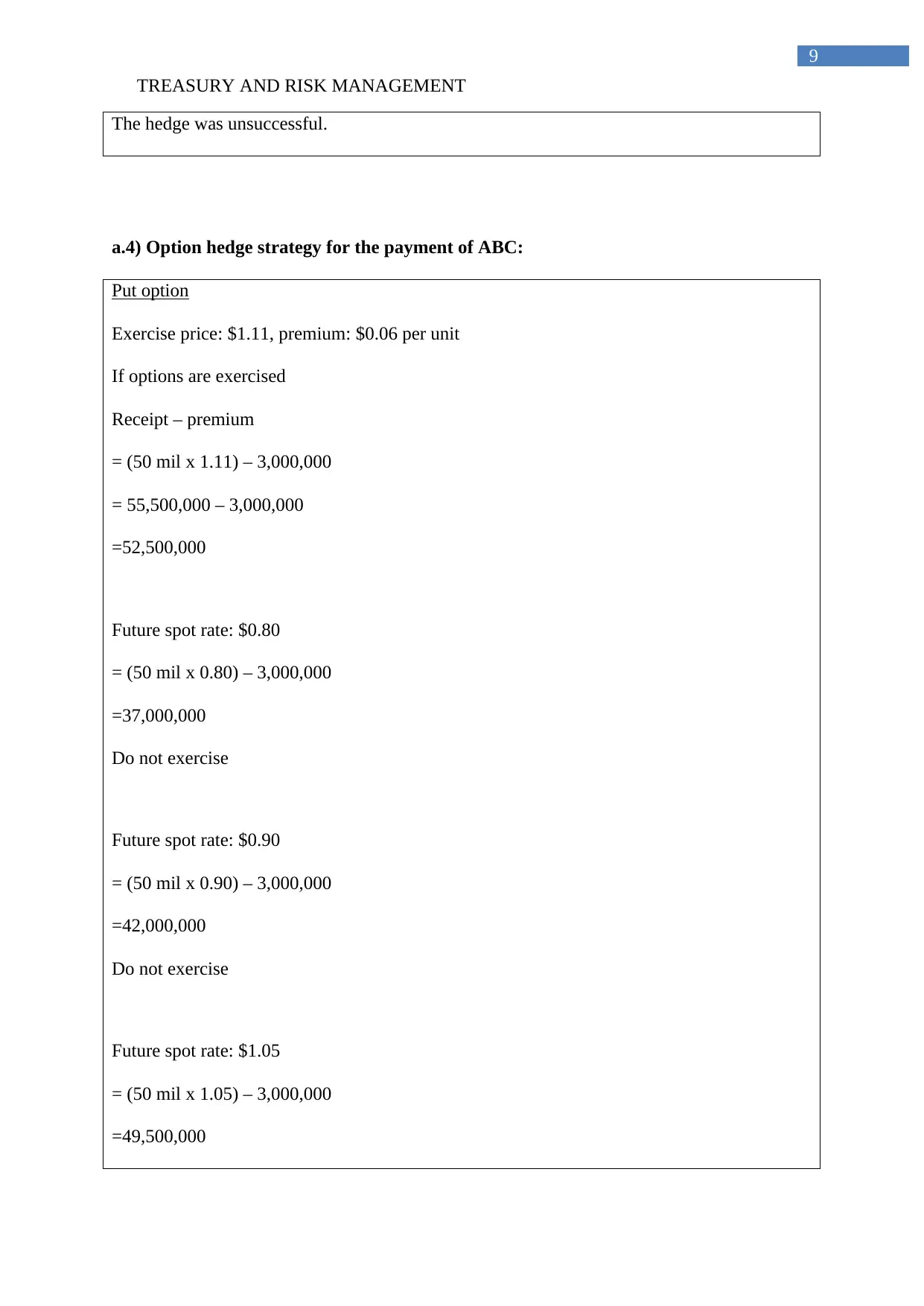
TREASURY AND RISK MANAGEMENT
9
The hedge was unsuccessful.
a.4) Option hedge strategy for the payment of ABC:
Put option
Exercise price: $1.11, premium: $0.06 per unit
If options are exercised
Receipt – premium
= (50 mil x 1.11) – 3,000,000
= 55,500,000 – 3,000,000
=52,500,000
Future spot rate: $0.80
= (50 mil x 0.80) – 3,000,000
=37,000,000
Do not exercise
Future spot rate: $0.90
= (50 mil x 0.90) – 3,000,000
=42,000,000
Do not exercise
Future spot rate: $1.05
= (50 mil x 1.05) – 3,000,000
=49,500,000
9
The hedge was unsuccessful.
a.4) Option hedge strategy for the payment of ABC:
Put option
Exercise price: $1.11, premium: $0.06 per unit
If options are exercised
Receipt – premium
= (50 mil x 1.11) – 3,000,000
= 55,500,000 – 3,000,000
=52,500,000
Future spot rate: $0.80
= (50 mil x 0.80) – 3,000,000
=37,000,000
Do not exercise
Future spot rate: $0.90
= (50 mil x 0.90) – 3,000,000
=42,000,000
Do not exercise
Future spot rate: $1.05
= (50 mil x 1.05) – 3,000,000
=49,500,000
Secure Best Marks with AI Grader
Need help grading? Try our AI Grader for instant feedback on your assignments.
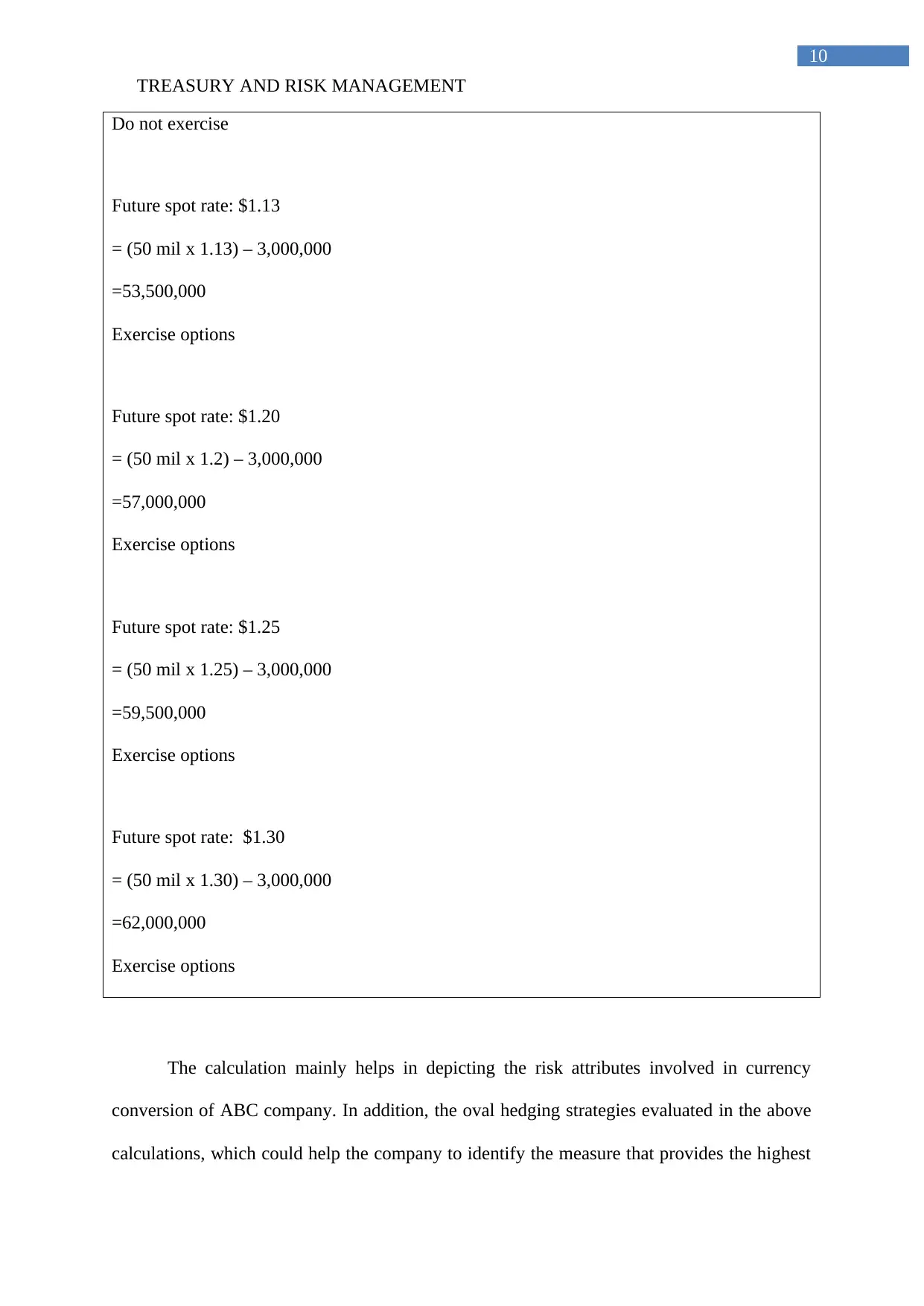
TREASURY AND RISK MANAGEMENT
10
Do not exercise
Future spot rate: $1.13
= (50 mil x 1.13) – 3,000,000
=53,500,000
Exercise options
Future spot rate: $1.20
= (50 mil x 1.2) – 3,000,000
=57,000,000
Exercise options
Future spot rate: $1.25
= (50 mil x 1.25) – 3,000,000
=59,500,000
Exercise options
Future spot rate: $1.30
= (50 mil x 1.30) – 3,000,000
=62,000,000
Exercise options
The calculation mainly helps in depicting the risk attributes involved in currency
conversion of ABC company. In addition, the oval hedging strategies evaluated in the above
calculations, which could help the company to identify the measure that provides the highest
10
Do not exercise
Future spot rate: $1.13
= (50 mil x 1.13) – 3,000,000
=53,500,000
Exercise options
Future spot rate: $1.20
= (50 mil x 1.2) – 3,000,000
=57,000,000
Exercise options
Future spot rate: $1.25
= (50 mil x 1.25) – 3,000,000
=59,500,000
Exercise options
Future spot rate: $1.30
= (50 mil x 1.30) – 3,000,000
=62,000,000
Exercise options
The calculation mainly helps in depicting the risk attributes involved in currency
conversion of ABC company. In addition, the oval hedging strategies evaluated in the above
calculations, which could help the company to identify the measure that provides the highest
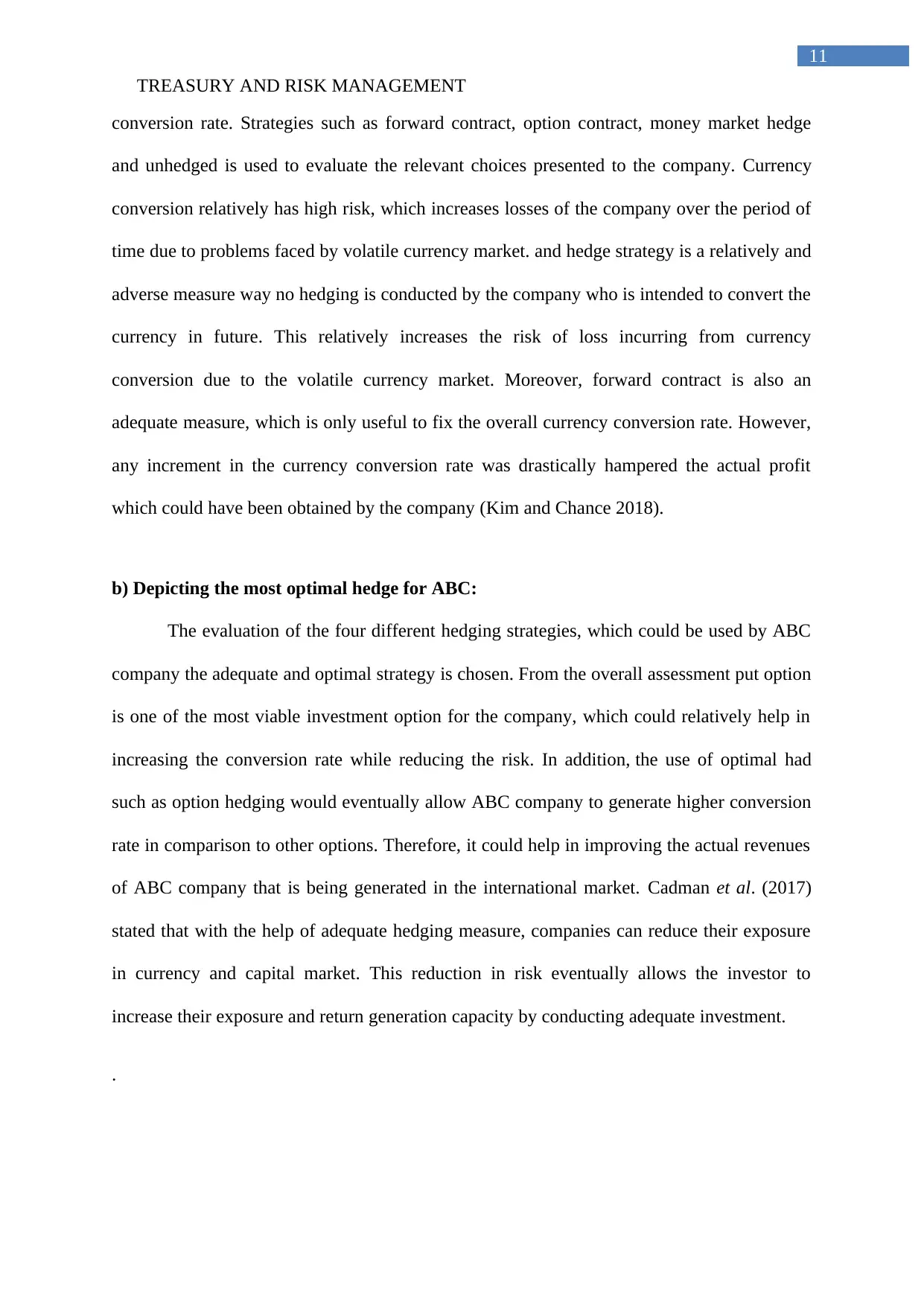
TREASURY AND RISK MANAGEMENT
11
conversion rate. Strategies such as forward contract, option contract, money market hedge
and unhedged is used to evaluate the relevant choices presented to the company. Currency
conversion relatively has high risk, which increases losses of the company over the period of
time due to problems faced by volatile currency market. and hedge strategy is a relatively and
adverse measure way no hedging is conducted by the company who is intended to convert the
currency in future. This relatively increases the risk of loss incurring from currency
conversion due to the volatile currency market. Moreover, forward contract is also an
adequate measure, which is only useful to fix the overall currency conversion rate. However,
any increment in the currency conversion rate was drastically hampered the actual profit
which could have been obtained by the company (Kim and Chance 2018).
b) Depicting the most optimal hedge for ABC:
The evaluation of the four different hedging strategies, which could be used by ABC
company the adequate and optimal strategy is chosen. From the overall assessment put option
is one of the most viable investment option for the company, which could relatively help in
increasing the conversion rate while reducing the risk. In addition, the use of optimal had
such as option hedging would eventually allow ABC company to generate higher conversion
rate in comparison to other options. Therefore, it could help in improving the actual revenues
of ABC company that is being generated in the international market. Cadman et al. (2017)
stated that with the help of adequate hedging measure, companies can reduce their exposure
in currency and capital market. This reduction in risk eventually allows the investor to
increase their exposure and return generation capacity by conducting adequate investment.
.
11
conversion rate. Strategies such as forward contract, option contract, money market hedge
and unhedged is used to evaluate the relevant choices presented to the company. Currency
conversion relatively has high risk, which increases losses of the company over the period of
time due to problems faced by volatile currency market. and hedge strategy is a relatively and
adverse measure way no hedging is conducted by the company who is intended to convert the
currency in future. This relatively increases the risk of loss incurring from currency
conversion due to the volatile currency market. Moreover, forward contract is also an
adequate measure, which is only useful to fix the overall currency conversion rate. However,
any increment in the currency conversion rate was drastically hampered the actual profit
which could have been obtained by the company (Kim and Chance 2018).
b) Depicting the most optimal hedge for ABC:
The evaluation of the four different hedging strategies, which could be used by ABC
company the adequate and optimal strategy is chosen. From the overall assessment put option
is one of the most viable investment option for the company, which could relatively help in
increasing the conversion rate while reducing the risk. In addition, the use of optimal had
such as option hedging would eventually allow ABC company to generate higher conversion
rate in comparison to other options. Therefore, it could help in improving the actual revenues
of ABC company that is being generated in the international market. Cadman et al. (2017)
stated that with the help of adequate hedging measure, companies can reduce their exposure
in currency and capital market. This reduction in risk eventually allows the investor to
increase their exposure and return generation capacity by conducting adequate investment.
.
1 out of 12
Related Documents
Your All-in-One AI-Powered Toolkit for Academic Success.
+13062052269
info@desklib.com
Available 24*7 on WhatsApp / Email
![[object Object]](/_next/static/media/star-bottom.7253800d.svg)
Unlock your academic potential
© 2024 | Zucol Services PVT LTD | All rights reserved.




